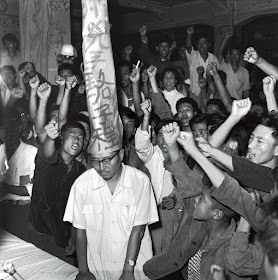As this unit focuses on China's modernisation during the 20th Century, it makes sense for the Cultural Revolution to be viewed as the linchpin of this era. It therefore felt worthwhile to spend another lesson on this time period, one that was partially reliant on the previous lesson's content.
The main purpose of this lesson was that I wanted to try my hand at a 'floorstorm' activity, something that I picked up from Joanne Rossbridge and the Grammar and Teaching Course she conducts with Kathy Rushton. At first glance, a floorstorm is a slightly complicated-looking series of steps that students undertake with an array of resources. On the plus side though, it should roughly take an entire 1 hour lesson, and works as a scaffold to assist students in constructing their own paragraphs about a subject they are currently immersed in.
Step 1
Verbally prime the students for the lesson by asking them what they can tell you about the Cultural Revolution from the previous lesson. Ask them how they know this. This could be done as a discussion or a mind map.
Step 2
Use Resource 5-1 (or copies of the pictures at the bottom of this blog) to create several 7-picture photo sets. Students are to work in groups of 3-5 with a set of photos for each group, and come up with a list of words that could be associated with the pictures. Give each group some post-it notes to write these words on.
Step 3
Groups classify words into a table using Resource 5-2. They choose/create the categories they want to use to classify the words. It's important that the students come up with these categories themselves as taxonomy-building is an important literacy skill that links with student grammar development. It forces the students to think about the purpose of the words they've just come up with - whether they separate them by function (verbs, nouns, adjectives), or by content (people, places, events) or some other way of their own making.
Step 4
Reveal the title of the photo set to the students as 'Public Struggle Sessions'. Using this clue, students are to then tick the words that they think will be in an unseen text about these photos. This incorporation of a prediction activity fits in with the Super 6 Comprehension Strategies and also directs the students in further building a lexicon to work with in regards to the subject of 20th Century China.
Make a list on the board from the class' suggestions (this may help students who have been struggling up until this point - it's important to have these checkpoints where these students can 'opt in' to the lesson so that you avoid a full hour's worth of disengagement)
Step 5
Teacher reads Resource 5-3 to students (they are not given a copy). Students are to listen and highlight/circle the words from their list that show up. After this, read the sheet again and have students make notes using the scaffold found in Resource 5-4.
Step 6
Hand students Resource 5-5. This is an annotated version of Resource 5-3 that asks a variety of grammar-related questions surrounding the text. Teacher also projects this version onto the board to facilitate discussion and instruction as students work through the sheet.
Step 7
Almost there! Students now use Resource 5-6 to pull the text apart into some pre-set categories. Specifically, students identify clauses / sentence noun groups (the teacher can help here, after all - that's what we do!) and examine them for modality and emotive language. Using this scaffolding they can then draw some conclusions from the source.
Step 8
And now that your students have done all of this, get them to use any and all of the information to construct their own paragraph with the heading 'Public Struggle Sessions'.
I know it's a lot of steps so you will need to work at a brisk pace, moving around the room from group to group to keep students on task. A big visible timer might be helpful too! The important thing is that the students collect together all these new terms while engaging with a text and are then able to write about it.
Links to resources
Resource 5-1: Photo Set
Resource 5-2: Table
Resource 5-3: Struggle Sessions
Resource 5-4: Note Taking
Resource 5-5: Struggle Sessions Annotated
Resource 5-6: Graphic Organiser
For printing purposes, here are the pictures from the photo sets as .jpgs
Obviously I don't have copyright for these pictures but they should be okay for educational usage. If anyone thinks otherwise please let know and I'll take them down.









No comments:
Post a Comment